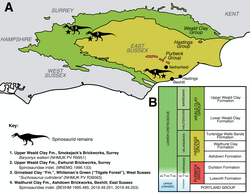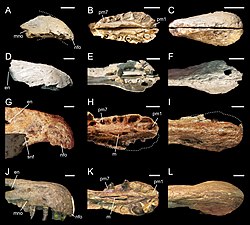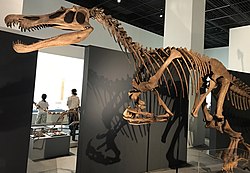Baryonyx
Baryonyx was a carnivorous theropod dinosaur discovered in clay pits just south of Dorking, England, and also in northern Spain. It has been dated to the Barremian stage of the Lower Cretaceous period, between 130 to 125 million years ago.
| Baryonyx | |
|---|---|

| |
| Reconstruction of the holotype skeleton, National Museum of Nature and Science, Tokyo | |
| Scientific classification | |
| Kingdom: | Animalia |
| Phylum: | Chordata |
| Family: | Spinosauridae |
| Genus: | Baryonyx Charig & Milner, 1986 |
| Species: | B. walkeri
|
| Binomial name | |
| Baryonyx walkeri Charig & Milner, 1986
| |
It was first discovered in 1983 by the amateur fossil hunter William Walker. A group of scientists lead by Alan Charig and Angela Milner of the Natural History Museum of London examined the skeleton and named the animal Baryonyx (meaning 'heavy claw'), and the species name walkeri after the man who discovered it.[1] Other good skeletons were discovered in England and in Spain, which gave scientists a good idea of what the dinosaur was like.
Baryonyx grew up to between 7.5 and 10 metres (25 and 33 feet) long and weighed 1.2 and 1.7 t (1.3 and 1.9 short tons), and 1.8 meters (6 feet) tall at head. It had long arms which were probably used for holding on to prey, the claw on the first finger was 31 centimeters (12 in) long. It ate mostly fish, like a grizzly bear would; for this it had a long snout like a gharial, and straight, cone-like teeth perfect for fishing. It had a triangle-shaped crest on the top of its skull.[2]
Reconstruction of Baryonyx with a fish in its jaws
Baryonyx (in yellow, second from left) compared in size to a human and other spinosaurid dinosaurs
Baryonyx Media
Map showing spinosaurid localities of southeast England; 1 is the Smokejack Clay Pit where Baryonyx was found
Skeletal diagram of Baryonyx with the bones of Portuguese specimen ML1190 shown in red; it was originally considered a specimen of Baryonyx, but was since moved to Iberospinus
Skeletal diagram of the holotype specimen (below) compared with the related genus Suchomimus
A reconstruction of the skull of Baryonyx on display at Dinosaur Isle
Comparison between the snouts of Suchomimus (A, B), Cristatusaurus (C, D), and Baryonyx (E)
References
- ↑ Edwards, D. D. (1986). "Fossil claw unearths a new family tree". Science News. 130 (23): 356. doi:10.2307/3970849. JSTOR 3970849.
- ↑ Psihoyos, L.; Knoebber, J. (1994). Hunting Dinosaurs. London: Cassell. pp. 176–179. ISBN 978-0679431244.







